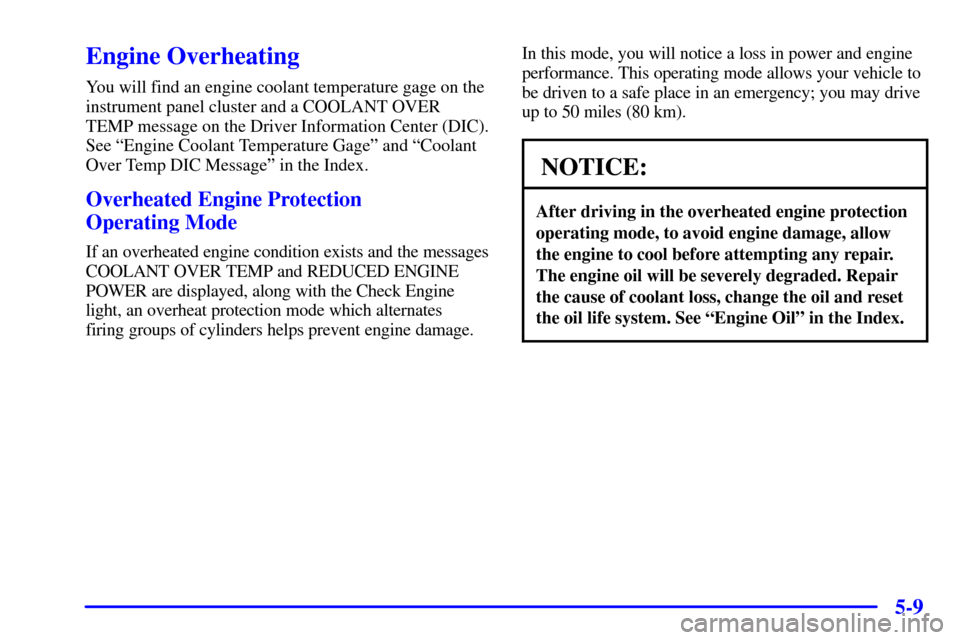Page 172 of 384
2-114
Other Messages
Here are more messages that you can receive on your
Driver Information Center (DIC). To acknowledge a
message and read another message that may have
come on at the same time, press the RESET button.
�BRAKE BEFORE SHIFT
(Automatic Transmissions Only)
�CHANGE OIL NOW
(See ªGM Oil Life System�º in the Index.)
�CHANGE OIL SOON
(See ªGM Oil Life System�º in the Index.)
�CRUISE DISENGAGED
(See ªCruise Controlº in the Index.)
�CRUISE SET __ MPH (__ km/h)
(See ªCruise Controlº in the Index.)
�DOOR AJAR�ENGINE PROTECTION REDUCE ENGINE RPM
�HATCH AJAR (Coupe)
�HIGH VOLTAGE (See ªVoltmeterº in the Index.)
�LOW BRAKE FLUID
(See ªBrake Fluidº in the Index.)
�LOW FUEL (See ªFuel Gageº in the Index.)
�LOW VOLTAGE (See ªVoltmeterº in the Index.)
�LOW WASHER FLUID
(See ªWindshield Washer Fluidº in the Index.)
�RESERVE FUEL (See ªFuel Gageº in the Index.)
�TONNEAU AJAR (Convertible)
�TRUNK AJAR (Convertible/Z06)
�UPSHIFT NOW
(See ªManual Transmissionº in the Index.)
Page 173 of 384

2-115
Head-Up Display (HUD) (If Equipped)
CAUTION:
If the HUD image is too bright, or too high in
your field of view, it may take you more time to
see things you need to see when it's dark outside.
Be sure to keep the HUD image dim and placed
low in your field of view.
If your vehicle is equipped with the Head-Up Display
(HUD), you can see some of the driver information that
appears on your instrument panel cluster.The information may be displayed in English or metric
units and appears as an image focused out toward
the front of your vehicle. The HUD consists of the
following information:
�Speedometer
�Turn Signal Indicators
�High
-Beam Indicator Symbol
�Tachometer
�Oil, Temperature and Fuel Gages
�Shift Light (Performance SHIFT Light)
This light is used for performance driving to indicate
that the vehicle's best performance level has been
reached to shift the transmission into the next
higher gear. The SHIFT light will display at an
engine speed of about 5,750 rpm (6,250 rpm
on Z06), just prior to reaching the engine fuel
cut
-off mode. To better understand the vehicle's
power curves, see ªCapacities and Specificationsº
in the Index.
�Check Gages Icon
Page 179 of 384

3-3
(Defog): This setting divides the air between the
windshield and lower outlets with a small amount of air
directed toward the side window vents. This is useful
when fog appears on the windshield or side glass due to
rain or snowy conditions.
(Defrost): Use this setting to quickly remove fog or
frost from the windshield. This setting directs most of
the airflow to the windshield with a small amount of air
directed toward the lower and side window outlets.
Mode Buttons
These buttons control the air intake, the air conditioning
and the rear window defogger operation.
(Outside Air): Press this button and it will bring
outside air into the vehicle. The light on the button will
come on when operating. Use this setting while trying to
defrost or defog windows to help clear moisture.
(Recirculate): Press this button to limit the amount
of outside air entering the vehicle by recirculating most
of the air inside the vehicle. The light on the button will
come on when operating. This setting is helpful when
you are trying to cool the air quickly or to limit odors
entering the vehicle. Recirculate cannot be used while in
the defrost or defog modes.Operating the system in the recirculation mode may
cause fogging of the vehicle's windows when the
weather is cold and damp. To clear the fog, switch the
system to either the defog or defrost mode and increase
the fan speed. To avoid re
-fogging of the windows,
operate the system in the outside air mode.
A/C (Air Conditioning): This button turns the
air conditioning compressor off or on under most
conditions. The light on the A/C button comes on
when the compressor is operating. The air conditioning
does not operate at temperatures below approximately
35�F to 40�F (2�C to 4�C). The air conditioning
cools and dehumidifies the air coming into the vehicle.
The air conditioning cannot be turned off in defrost,
as it helps to remove moisture from the vehicle. It also
helps to keep the windows clear.
The air conditioning may be forced off at high engine
speeds or high engine oil or coolant temperatures.
See ªRear Window Defoggerº later in this section for
more information.
Page 184 of 384

3-8
Function Buttons
These buttons control the climate control ON/OFF,
air intake, front defrost, rear defrost and the air
conditioning operation.
OFF: Press the OFF button to turn off the climate
control system. This is the only setting that fully
shuts off the fan. The digital display will show only the
outside temperature. You can still adjust the driver set
temperature, the passenger temperature offset and the
air intake mode while in OFF.
A/C (Air Conditioning): This button turns
the air conditioning compressor off or on under most
conditions. The light on the A/C button will come on
when the compressor is operating in either the automatic
or manual mode. The air conditioning does not operate
at temperatures below approximately 35�F to 40�F
(2�C to 4�C). The light on the A/C button will flash if
pressed when air conditioning is not available. The air
conditioning cools and dehumidifies the air coming into
the vehicle. The air conditioning cannot be turned off in
defrost and defog, as it helps to remove moisture from
the vehicle. It also helps to keep the windows clear.If the system is operating in the AUTO mode, turning
the air conditioning off will delete AUTO from the
digital display and show current mode and fan settings.
The AUTO button must be pressed to return to the
automatic mode operation.
The air conditioning may be forced off at high engine
speeds or high engine oil or coolant temperatures.
(Outside Air): Press this button to provide outside
air. The light on this air intake button will come on to
show when it is operating. When in the AUTO mode,
the system automatically selects outside air instead of
recirculate, as required, to control the temperature in the
vehicle. By pressing outside air, the system will lock
into the outside air mode. Any adjustment to the air
intake must then be made manually. Outside air should
be used when trying to defrost or defog windows to help
reduce moisture inside of the vehicle.
Page 236 of 384

4-25
Here are some things you can check before a trip:
�Windshield Washer Fluid: Is the reservoir full?
Are all windows clean inside and outside?
�Wiper Blades: Are they in good shape?
�Fuel, Engine Oil, Other Fluids: Have you checked
all levels?
�Lamps: Are they all working? Are the lenses clean?
�Tires: They are vitally important to a safe,
trouble
-free trip. Is the tread good enough for
long
-distance driving? Are the tires all inflated
to the recommended pressure?
�Weather Forecasts: What's the weather outlook
along your route? Should you delay your trip a
short time to avoid a major storm system?
�Maps: Do you have up
-to-date maps?
Highway Hypnosis
Is there actually such a condition as ªhighway hypnosisº?
Or is it just plain falling asleep at the wheel? Call it
highway hypnosis, lack of awareness, or whatever.
There is something about an easy stretch of road with the
same scenery, along with the hum of the tires on the road,
the drone of the engine, and the rush of the wind against
the vehicle that can make you sleepy. Don't let it happen
to you! If it does, your vehicle can leave the road in less
than a second, and you could crash and be injured.
What can you do about highway hypnosis?
First, be aware that it can happen.
Then here are some tips:
�Make sure your vehicle is well ventilated,
with a comfortably cool interior.
�Keep your eyes moving. Scan the road ahead
and to the sides. Check your rearview mirrors
and your instruments frequently.
�If you get sleepy, pull off the road into a rest,
service or parking area and take a nap, get some
exercise, or both. For safety, treat drowsiness on
the highway as an emergency.
Page 254 of 384

5-9
Engine Overheating
You will find an engine coolant temperature gage on the
instrument panel cluster and a COOLANT OVER
TEMP message on the Driver Information Center (DIC).
See ªEngine Coolant Temperature Gageº and ªCoolant
Over Temp DIC Messageº in the Index.
Overheated Engine Protection
Operating Mode
If an overheated engine condition exists and the messages
COOLANT OVER TEMP and REDUCED ENGINE
POWER are displayed, along with the Check Engine
light, an overheat protection mode which alternates
firing groups of cylinders helps prevent engine damage. In this mode, you will notice a loss in power and engine
performance. This operating mode allows your vehicle to
be driven to a safe place in an emergency; you may drive
up to 50 miles (80 km).
NOTICE:
After driving in the overheated engine protection
operating mode, to avoid engine damage, allow
the engine to cool before attempting any repair.
The engine oil will be severely degraded. Repair
the cause of coolant loss, change the oil and reset
the oil life system. See ªEngine Oilº in the Index.
Page 257 of 384
5-12
Cooling System
When you decide it's safe to lift the hood, here's what
you'll see:
A. Electric Engine Cooling Fans
B. Coolant Surge Tank
CAUTION:
An electric engine cooling fan under the hood can
start up even when the engine is not running and
can injure you. Keep hands, clothing and tools
away from any underhood electric fan.
If the coolant inside the coolant surge tank is boiling,
don't do anything else until it cools down. The vehicle
should be parked on a level surface.
Page 261 of 384
5-16
CAUTION:
Adding only plain water to your cooling system
can be dangerous. Plain water, or some other
liquid such as alcohol, can boil before the proper
coolant mixture will. Your vehicle's coolant
warning system is set for the proper coolant
mixture. With plain water or the wrong mixture,
your engine could get too hot but you wouldn't
get the overheat warning. Your engine could
catch fire and you or others could be burned.
Use a 50/50 mixture of clean, drinkable water
and DEX
-COOL� coolant.
NOTICE:
In cold weather, water can freeze and crack the
engine, radiator, heater core and other parts.
So use the recommended coolant.
CAUTION:
You can be burned if you spill coolant on hot
engine parts. Coolant contains ethylene glycol
and it will burn if the engine parts are hot
enough. Don't spill coolant on a hot engine.